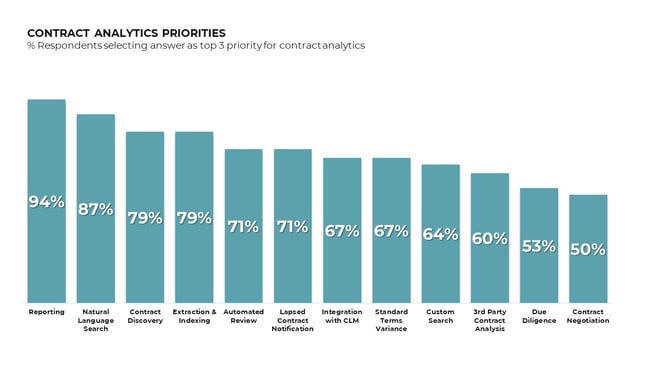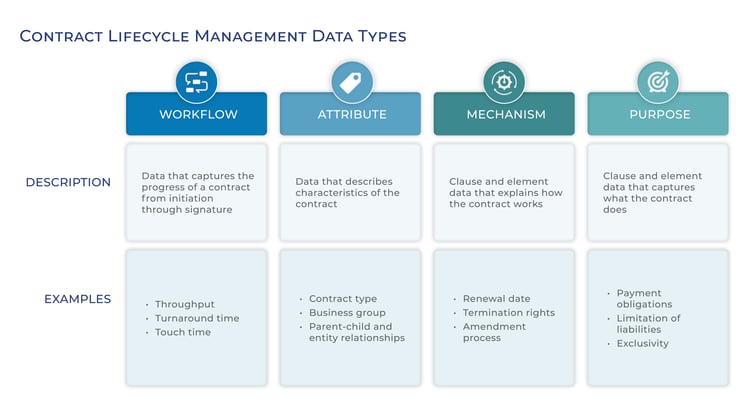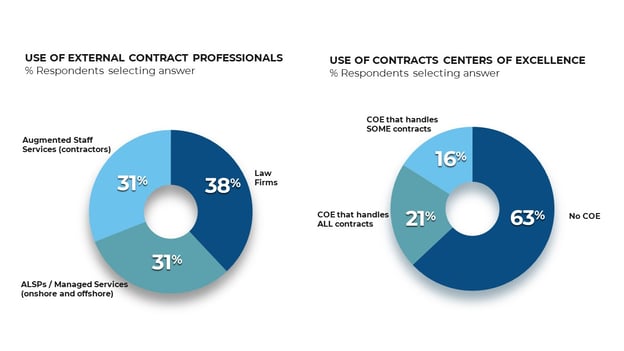
Contract Management; Improving Value Through Data Analytics & Better Resourcing Models
When considering how to transform contracting, focus turns quickly to applying technology to drive efficiency. But optimizing contracting operations involves orchestrating the interplay among people, processes, policies, technology and importantly, the data the technology generates. Hyperion Research data shows that legal departments utilizing contract analytics, whether embedded in their CLM solutions or through separate pre- or post-signature Contract Analytics solutions, to improve across a wide spectrum of needs from reporting and search to negotiation.

ACTIONABLE INSIGHTS THROUGH CONTRACT ANALYTICS
Data we can collect about and from contracts supports all of the benefits we set forth in the last installment of this series, focused on making the case for and demonstrating the value of investing in legal-specific contracting technology. Aside from litigation and e-discovery, the earliest and strongest use cases of AI in corporate legal departments have been in contracting technology. Some legal departments indirectly benefit from contract analytics provided by managed services providers that utilize AI-driven contract analytics solutions.
The types of AI most used in contract analytics (CA) solutions are natural language processing (NLP) to “read” and analyze the text in contracts, and machine learning (ML) to create models based on training data. The term “AI” is often oversold and underdelivered, due to insufficient understanding by sellers and buyers. AI within contracting technology isn’t magic, and it doesn’t alleviate the need for human oversight and review. It will likely, however, render a more accurate return of results than solely relying on humans (i.e., higher than 80% accuracy). But it’s important to set the right expectations before implementing a Contract Analytics solution.
Contracts Analytics data breaks down into four categories – workflow, attribute, mechanism and purpose data. The first two look at data that characterizes the contract – where it is in the contracting process (e.g., escalated to Legal for review) or important attributes the contract may have (e.g., contract type, contract family hierarchy). Mechanism and purpose data are about the contents of a contract. Mechanism data describes how the contract works (e.g., parties, term) and purpose data describes what the contract does (e.g., exclusivity arrangements, payment terms).

We can combine the different data types, aggregate, and slice by important characteristics. Sample contract analytics use cases include:
Redlining Intelligence. Some pre-signature contracts analytics solutions can review third party drafts against the standard company terms and identify and redline missing and off-standard provisions.
Workflow Intelligence. CLMs that include robust contract analytics capabilities particularly shine at providing insight into bottlenecks. By combining workflow data and contract metadata, you can see which steps in the process have long cycle times and then explore further. For example, if you spot a long time for the “legal escalation” process step, you can check whether it affects all contract types and all provisions. Maybe it’s the IP escalations that take a long time, skewing the average. Once you identify the issue, you can collaborate with the relevant stakeholders to improve the process and reduce cycle time.
Template & Playbook Intelligence. Endless rounds of negotiation drive up cycle time. By using data on which provisions cause the most negotiation turns and the typical position you accept, you can potentially adjust the template starting point or build out the playbook to reduce escalations. Post-signature, you can apply the same logic to identify the clauses that cause the most disputes and how they turn out to adjust the template/playbook.
Contractual Obligations Intelligence. The most accessible example following the Covid-19 pandemic is the need to understand contractual obligations in force majeure clauses. Some contracts were on company paper with standard force majeure terms, while others were on company paper but with negotiated terms or on third-party paper. It proved critical to figure out quickly what force majeure terms applied. Contract analytics can pull specific provisions for a corpus of legacy contracts, even where provisions are not already tagged with metadata or do not contain easily searchable language. Some contracts analytics solutions can create structured data based on the language, such as classifying each contract as “standard” or “non-standard” for specific terms.
And of course, operational intelligence is also critical for pinpointing opportunities for process improvements and resource optimization.
GETTING THE RIGHT WORK INTO THE RIGHT HANDS
With technology-enabled processes, legal departments have the data to calibrate resourcing and staffing to contract value. Hyperion benchmarking data shows that while law firms still handle the highest percent (38%) of contract work not performed by in-house staff, alternative/managed legal service providers and contract lawyers/paralegals now handle a sizable proportion of externally resourced contract work (31% in each category). To optimize internal contracting resources by taking slack out of the solution, centers of excellence (pooled/shared staff) are employed by over a third of legal departments, and one-sixth use COEs for all contracts.
 Legal departments with a high volume and variety of contract requirements use a blend of internal and external resources, applying risk and value calibration models to fulfil contracts, employing managed services as well as law firms depending on type and complexity, and engaging in-house or law firm counsel in negotiations only for the highest value/risk and strategically core contracts.
Legal departments with a high volume and variety of contract requirements use a blend of internal and external resources, applying risk and value calibration models to fulfil contracts, employing managed services as well as law firms depending on type and complexity, and engaging in-house or law firm counsel in negotiations only for the highest value/risk and strategically core contracts.
All in all, the most sophisticated CLM solutions enable relationship management ecosystems to transfer and act upon information in order to conduct pre- and post-signature contracting processes at the accelerating speed of business.
GREATER JOB SATISFACTION AND RETENTION
Combining contracting technology with smart resourcing and staffing models shifts the distribution of routine contracts work from going to all legal professionals in the department, regardless of seniority, to a center of excellence with the requisite standard templates, playbooks, and clause libraries. By leveraging this approach the company gets consistent handling of routine contracts by a smaller set of specialized team members. Secondly, more seasoned attorneys or negotiators can focus on more demanding bespoke contracts and/or deeper collaboration with business units on more proactive, strategic work. In addition to more appropriate allocation of task to talent, a company is likely to see higher retention rates of employees because people working at their highest and best use are more motivated and less likely to leave the organization.
In our previous posts, we discussed CLM and CA investment and market trends and how to make your Contract Management business case across departments.
In our final installment of this series, we will share 10 tips for preparing for a successful contracting technology journey.


